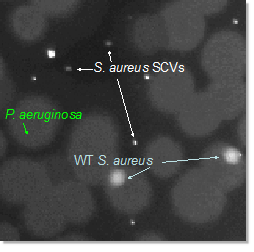The majority of the focus of microbiological research in CF and other chronic lung infections has been on specific bacteria, such as Pseudomonas aeruginosa and Staphylococcus aureus. However, recent work by many laboratories reveals that many chronic lung infections are polymicrobial, involving very diverse collections of microbes infecting together. These microbes may interact in ways that change their growth, virulence, and response to treatment.
For example, we found that growth of S. aureus and P. aeruginosa gradually selects for S. aureus small-colony variants, slow-growing mutant S. aureus that are highly resistant to many antibiotics and are associated with worse lung disease. Therefore, an interspecies bacterial interaction leads to antibiotic resistance without any need for prior antibiotic exposure. Conversely, we also found that S. aureus can favor the emergence of P. aeruginosa mutants (lasR mutants) that commonly infect CF patients and also exhibit altered growth and antibiotic susceptibilities and are associated with worse lung disease. Therefore, this two-species example illustrates how interspecies interactions may alter clinically-relevant behaviors in bacteria when growing together.
We are currently working to further understand the many interactions between these two pathogens- P. aeruginosa and S. aureus- and their relevance for CF and other infections. We are also expanding this model to characterize the integrated, community behaviors the complex, multispecies microbial consortia that can be found in the sputum from CF patients. For example, we are defining the responses to antibiotics of these intact communities, and the difference in these results compared with the isolated species. As current treatments often fail to lead to satisfactory clinical improvement, this work may identify improved treatment approaches for CF and other chronic, polymicrobial infections.


Legend: Top, growth of S. aureus (white and blue arrows) with P. aeruginosa (green arrow) selects for S. aureus small-colony variants, which are antibiotic resistant and associated with worse CF lung disease. Bottom: Growth of P. aeruginosa mutants known as lasR mutants (red arrows) is favored (note P. aeruginosa colony is thicker) by nearby S. aureus (blue arrow). lasR mutant P. aeruginosa also have lower susceptibilities to some antibiotics, and are associated with worse CF lung outcomes.


